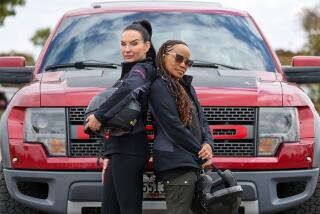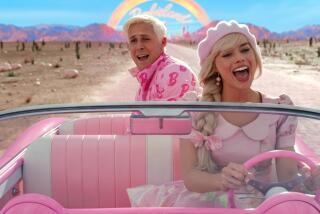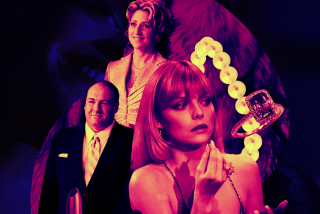Commentary: Some stereotyped women’s film roles we’d like to do away with
Break out the balloons and cake, we’d like to throw a retirement party — for some of the most insidious female stereotypes in Hollywood movies.
It’s been an eventful few years for women in Hollywood. With the #MeToo movement, a cathartic reckoning with and cleansing of sexual harassment in the industry, as well as continuing discussion about representation and inclusion both on-screen and behind the camera, it feels like a long-overdue seismic shift is underway.
Despite that, it sometimes seems as if these much discussed changes have yet to make their way to the screen, and the numbers prove it. In July 2017, USC’s Annenberg Inclusion Initiative released its annual report analyzing representation in top-grossing movies. Looking at 900 films from 2007 to 2016, researchers found that only 12% had gender-balanced casts.
However, it’s not just the number of female characters that’s the problem. Tired, regressive stereotypes continue to plague many of the female characters in TV and film, and it’s time to see them go.
Here are some candidates for cliched roles we’d like to put out to pasture.
1. The long-suffering wife.
See also: Wife on the phone.
Too often, movies about difficult men and male antiheroes feature wives whose only character trait is exasperation — to illustrate just how difficult that man is. In the recent L.A. heist film “Den of Thieves,” we know Gerard Butler’s tough detective character Big Nick is a madman because he eats a doughnut from a blood-spattered box in the middle of a crime scene, but that fact is underscored when his frustrated wife, Debbie (Dawn Olivieri) packs up and leaves, along with their daughters. Later, he barges in on her dinner date, and then cries next to a playground to clarify that yes, he does feel emotions. Debbie and their daughters aren’t actual characters with inner lives; they serve only to tell us more about Big Nick. Might as well just write them out, or at least offer them more characterization, because otherwise, they’re just pawns in this story.
On the flip side, many stories about male heroes use long-suffering wives to offer emotional stakes to a crisis. These women seem to always be tethered to a phone as they try to contact their husbands, whether at war or on a crashing plane, and let the phone slip from their hands only while watching a dramatic news report on TV. The best example of this would be Laura Linney’s Lorrie Sullenberger, wife of Charles “Sully” Sullenberger (Tom Hanks), in Clint Eastwood’s “Sully.”
2. Sexual conquest to help him get his mojo back
See also: The manic pixie dream girl
This character was popularized in pop culture with a gender swap of the stereotype in 1998’s “How Stella Got Her Groove Back,” with Angela Bassett and Taye Diggs. But more often than not, the female versions of these characters are flippantly used and discarded without any sort of development or nuance, like Katie Aselton’s Sarah in “Father Figures.” Ed Helms plays Peter, an uptight divorced doctor searching for his birth father with his twin brother, Kyle (Owen Wilson), but really, it’s a journey to find himself. And for Kyle, that means getting Peter laid, and any woman they encounter is an option. Peter finally succeeds, by swooping in on a sad Sarah, drinking alone at a hotel bar. The encounter puts a renewed spring in his step — bully for him.
Another version of this would be the manic pixie dream girl, as coined by film and music critic Nathan Rabin in 2007 to describe quirky, oddball female characters who help a man feel excited about life again. Natalie Portman’s Shins-listening weirdo Sam (hobbies include: primal screaming on top of heavy machinery) in “Garden State” is the best example of this, but notable manic pixie dream girls include Zooey Deschanel’s Summer in “500 Days of (Summer)” and Kirsten Dunst’s Claire in “Elizabethtown.”
3. The cold careerist
Katherine Heigl has made a career out of playing cold, careerist women who are eventually softened by love and marriage. Exploring those characters fully can be interesting, especially in the romcom “27 Dresses.” But those characters can drift into stereotype all too easily when the focus isn’t on them. See Bryce Dallas Howard’s notoriously derided Claire in “Jurassic World” — a woman so uptight, she wears high heels to work on a dinosaur island. Another indicator of her coldness? That perfectly sharp bob haircut. You see, as she becomes more relaxed, so does her hair. Get it?
4. The rape victim who inspires action
It’s a trope almost as old as cinema itself. From D.W. Griffith’s “Birth of a Nation” to Nate Parker’s “The Birth of a Nation,” female victims of violence (usually sexual) have inspired men to vengeance. In Griffith’s “Birth of a Nation,” the sexual violation of a white woman by a black man inspires the Ku Klux Klan to take to its hoods and torches. In Parker’s “The Birth of a Nation,” he employs not one, not two but at least three rapes to justify Nat Turner’s bloody massacre. The rapes are not a part of the Turner legend, but within a two-hour running time, that kind of gendered violence creates a narrative shortcut to justify his killing spree, shocking and horrifying the audience to get them on Turner’s side.
. In terms of character motivation, sexual violence against women is more often than not lazy screenwriting.
5. The plucky girl child who helps a man find his purpose
This can go one of two ways — super dark, like Jodie Foster’s teen prostitute Iris, who helps inspire Travis Bickle’s (Robert De Niro) shoot-em-up in “Taxi Driver.” It could also be more heart-warming, like in the sweet child prodigy film “Gifted,” where McKenna Grace’s math whiz Mary helps her guardian uncle Frank (Chris Evans) grow up. Either way you slice it, these plucky, precocious girls (always girls, rarely boys) help men find their destiny.
There are certainly valid ways to write these types of stories and characters. The problem is that most often, these characters aren’t developed enough to stand on their own — they serve only to aid a male character’s characterization or arc. It’s reflective of a predominantly male worldview. We can only hope that more inclusion of diverse voices will hasten the retirement of these stale and empty stereotypes.
Walsh is a Tribune News Service film critic and writer in Los Angeles.
More to Read
Only good movies
Get the Indie Focus newsletter, Mark Olsen's weekly guide to the world of cinema.
You may occasionally receive promotional content from the Los Angeles Times.






